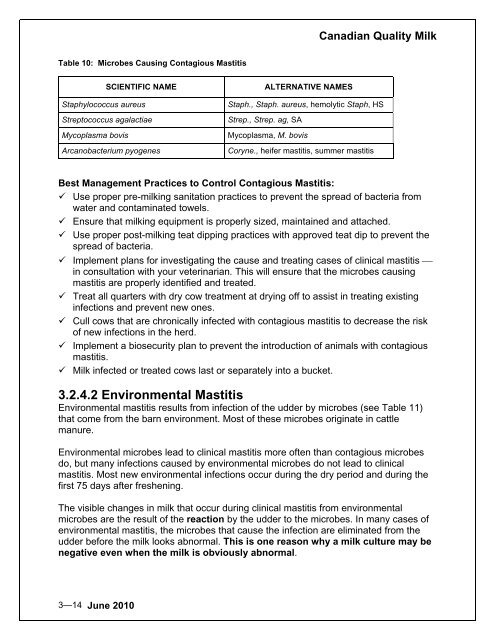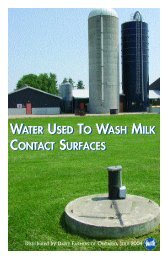Canadian Quality Milk On-Farm Food Safety Program - Centre ...
Canadian Quality Milk On-Farm Food Safety Program - Centre ...
Canadian Quality Milk On-Farm Food Safety Program - Centre ...
Create successful ePaper yourself
Turn your PDF publications into a flip-book with our unique Google optimized e-Paper software.
<strong>Canadian</strong> <strong>Quality</strong> <strong>Milk</strong><br />
Table 10: Microbes Causing Contagious Mastitis<br />
SCIENTIFIC NAME<br />
Staphylococcus aureus<br />
Streptococcus agalactiae<br />
Mycoplasma bovis<br />
Arcanobacterium pyogenes<br />
ALTERNATIVE NAMES<br />
Staph., Staph. aureus, hemolytic Staph, HS<br />
Strep., Strep. ag, SA<br />
Mycoplasma, M. bovis<br />
Coryne., heifer mastitis, summer mastitis<br />
Best Management Practices to Control Contagious Mastitis:<br />
Use proper pre-milking sanitation practices to prevent the spread of bacteria from<br />
water and contaminated towels.<br />
Ensure that milking equipment is properly sized, maintained and attached.<br />
Use proper post-milking teat dipping practices with approved teat dip to prevent the<br />
spread of bacteria.<br />
Implement plans for investigating the cause and treating cases of clinical mastitis ⎯<br />
in consultation with your veterinarian. This will ensure that the microbes causing<br />
mastitis are properly identified and treated.<br />
Treat all quarters with dry cow treatment at drying off to assist in treating existing<br />
infections and prevent new ones.<br />
Cull cows that are chronically infected with contagious mastitis to decrease the risk<br />
of new infections in the herd.<br />
Implement a biosecurity plan to prevent the introduction of animals with contagious<br />
mastitis.<br />
<strong>Milk</strong> infected or treated cows last or separately into a bucket.<br />
3.2.4.2 Environmental Mastitis<br />
Environmental mastitis results from infection of the udder by microbes (see Table 11)<br />
that come from the barn environment. Most of these microbes originate in cattle<br />
manure.<br />
Environmental microbes lead to clinical mastitis more often than contagious microbes<br />
do, but many infections caused by environmental microbes do not lead to clinical<br />
mastitis. Most new environmental infections occur during the dry period and during the<br />
first 75 days after freshening.<br />
The visible changes in milk that occur during clinical mastitis from environmental<br />
microbes are the result of the reaction by the udder to the microbes. In many cases of<br />
environmental mastitis, the microbes that cause the infection are eliminated from the<br />
udder before the milk looks abnormal. This is one reason why a milk culture may be<br />
negative even when the milk is obviously abnormal.<br />
3—14<br />
June 2010
















